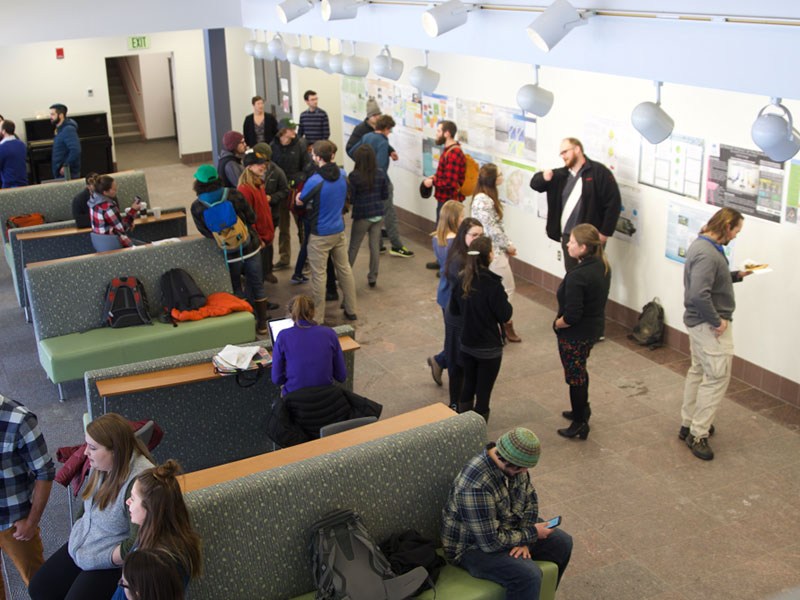Each year, seniors give a presentation on their thesis the week before graduation. As always, this year’s senior projects were varied. Topics included everything from “Alaska Zoo Polar Bears, Lost in Pace” and “Mesoamerican Geography and Student Engagement” to “History of medical Care in Seldovia Alaska” and “Suicide Awareness Training.”
Here are just five of the things we learned from the fall 2017 senior presentations:
The Army’s test for determining if a solider has PTSD after deployment is 16 questions long.
Liberal Studies major Steve Surita, an Army veteran who served 10 years active duty, participating in Operation Iraqi Freedom, Operation Enduring Freedom, and Operation New Dawn, spoke of his experiences with Post Traumatic Stress Disorder. In his presentation, he shared the 16 questions soldiers respond to 30 days post-deployment, including “are you making friends,” and “are you taking care of your health.” Surita argued, though a case study with four other vets, that the test wasn’t an accurate indicator of mental health and that the Army should investigate options like adventure therapy and art or music therapy.
Lyutyik, the male polar bear at the Alaska Zoo, originally came from Russia. Ahpun, the female, is from Alaska.
Marine & Environmental Sciences major Chelsie Wise’s senior thesis dealt with animal husbandry and enrichment for the polar bears at the zoo. Through several cameras set up in the bear enclosure, Wise observed stereotypic behaviors including the bears pacing, licking their paws, and swinging their heads, repeatedly. These behaviors, she said, are indicators of poor health. The goal of her project was seeing how various toys and food would allow the animals to have a more positive use of the environment, and therefore engage in more normal behaviors. With her information, they could create enrichment schedules that would keep the animals happier. Wise said while the Alaska Zoo tries to keep an ever-changing enrichment schedule, there’s always room for improvement.
The Salvation Army has several locations to help people battle addiction, homelessness, and hunger in Anchorage.
Falise Williams focused on Engaging Volunteers for her presentation and listed locations in the area where people might volunteer including The Salvation Army’s McKinnell House Family Shelter, Clitheroe Center, Serendipity Adult Day Services, Meals on Wheels and other’s including The Red Cross, Anchorage Performing Arts Center, Bridge Builders and Pioneer Homes.
Per capita Alaska has the highest rate of suicide in the country.
Nationally, one person every 40 seconds commits suicide. Counseling Psychology major David Dishman argued that the more training we have as a society, the more comfortable we will be asking others about suicidal thoughts. Dishman’s senior project, which dealt with suicidal awareness training, was implemented on his son’s Eagle Scout troop with the help of a Behavioral Health Consultant. To test the results of the training, the boys took a pre-test before the lessons to evaluate their understanding of how to determine cues if someone is having suicidal thoughts or is making plans toward that end. Following the training, the boys took the test again, to which Dishman discovered that their scores were significantly higher. From here, Dishman hopes petition to get suicidal awareness training incorporated as a Boy Scout merit badge.
One rock can have two different ages.
Lisa Koeneman, an Outdoor Studies major, focused on “Geochronology in the Alaska-Aleutian Batholith: Is there a correlation between a formation’s proximity to a fault system and the amount of discordance between the minerals in that formation?” During her studies, she found that hornblende and biotite minerals are commonly found in intrusive igneous rocks, which shows different ages. To explain that to the non-scientists in the room, Koeneman likened the rock to chocolate chip cookie dough ice cream. Imagine, she said, that you heat the ice cream up long enough that the chocolate chips melted, but the cookie dough chunks didn’t. Biotites, which have a lower melting rate, would in the example be the chocolate chips. In the case of rocks, when it reaches that melting point, argon is released. When it solidifies again (aka you put the ice cream back in the freezer), the argon is trapped and the amount of argon indicates to geologists how old the rock is.

